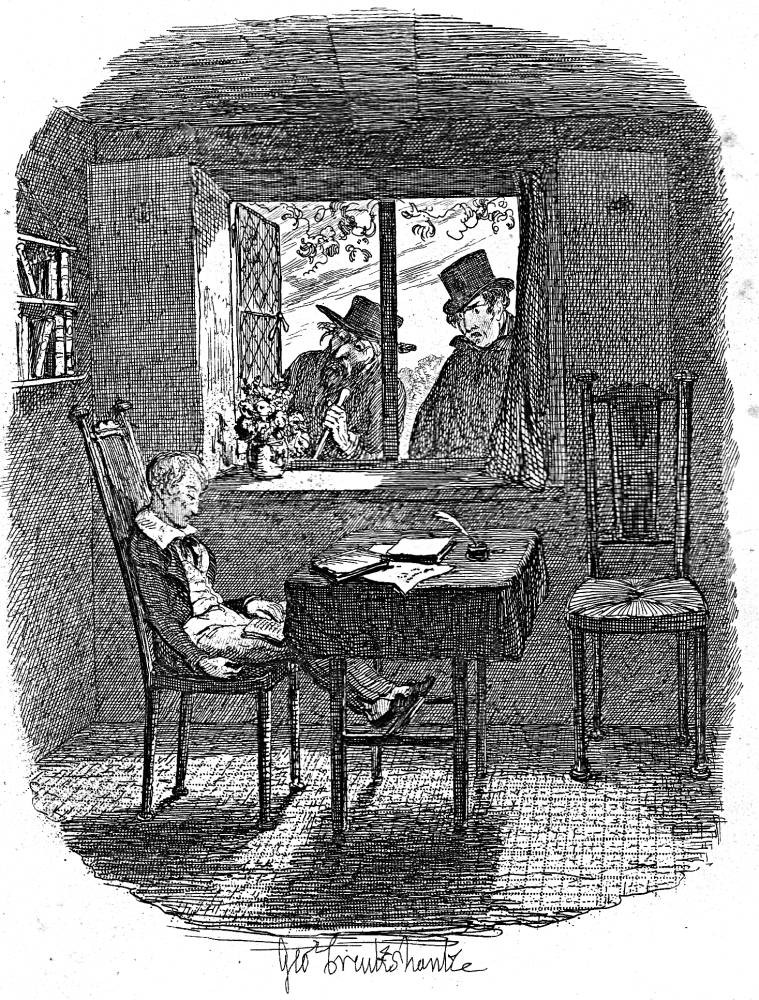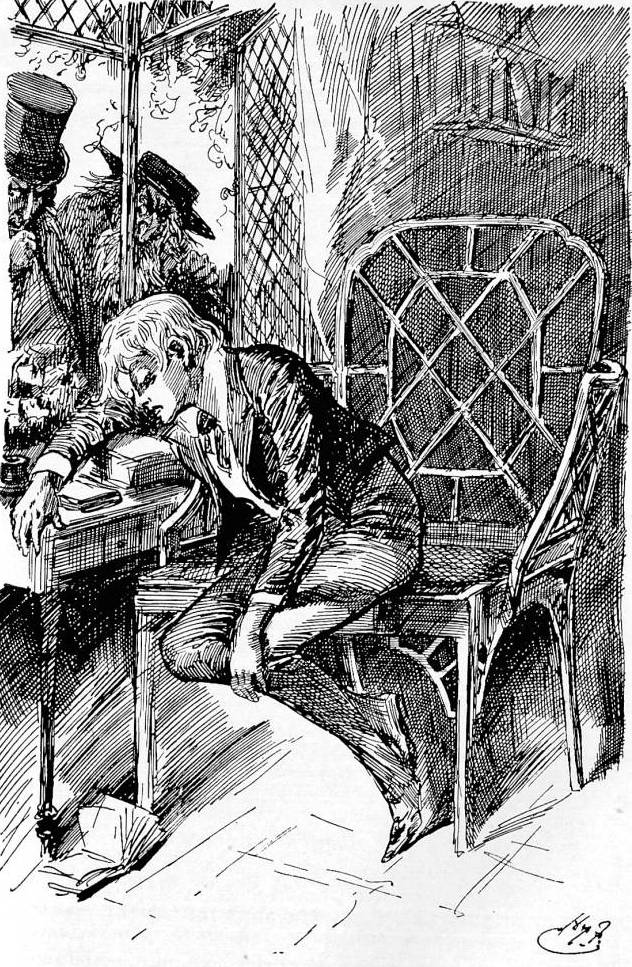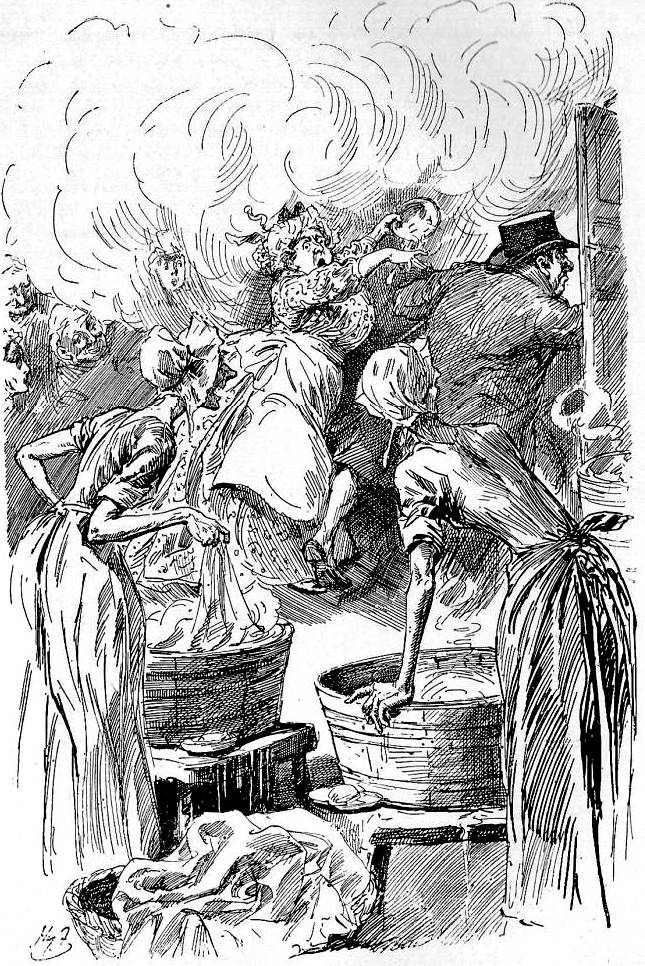
"Looking round, he saw that it was a post-chaise, driven at great speed." — James Mahoney's eighteenth illustration is about a lesser incident in Chapter 34 than the appearance of Fagin and Monks at Oliver's window. Mahoney, keenly aware that his predecessor had already treated the visit of Fagin and Monks to Oliver's home in the country, focusses on much earlier part in the narrative-pictorial sequence. Mahoney exploits the sudden appearance of a speeding carriage to create suspense in the Household Edition. In the original narrative-pictorial serial sequence by George Cruikshank in Bentley's Miscellany, the periodical reader encountered a pictorial realization of the terrifying moment which shatters Oliver's three-months' peace of mind Fagin and Monks in (Part 15, June 1838), for Chapter 34 of The Adventures of Oliver Twist; or, The Parish Boy's Progress. The speeding carriage is something of a red herring in that it has nothing to do with Monks, although it is connected with Rose Maylie's serious illness, an issue which has absorbed much of the previous chapter. In Chapter 33, Oliver's new-found happiness with the Maylies receives "a sudden check" (118) as Rose is suddenly stricken with a mysterious illness, which prompts Mrs. Maylie to summon Harry Maylie, her son, and request a visit from the family physician, Dr. Losberne. Agreeing to mail the necessary letters at The George Inn, Oliver cuts across the fields, and, having executed his commission in the nearby village, runs into a peculiar gentleman "in a horrible passion" (121), the incident occurring on the same page as the illustration. Receiving the optimistic diagnosis of Losberne that Rose will survive the illness, Oliver goes out to get some air, and is passed narrowly by a speeding post-chaise that contains — not Monks, the furious gentleman at the village — but the Maylies' butler, Giles, in a nightcap, and a young gentleman who proves to be Harry Maylie, in Chapter 34, page 123, the textual referent for the Mahoney illustration on page 121. 1871. Wood engraving by the Dalziels, 9.4 cm high by 13.7 cm wide.
Scanned image and text by Philip V. Allingham. [You may use this image without prior permission for any scholarly or educational purpose as long as you (1) credit the person who scanned the image and (2) link your document to this URL in a web document or cite it in a print one.]
Passage Realised
It was almost too much happiness to bear. Oliver felt stunned and stupefied by the unexpected intelligence; he could not weep, or speak, or rest. He had scarcely the power of understanding anything that had passed, until, after a long ramble in the quiet evening air, a burst of tears came to his relief, and he seemed to awaken, all at once, to a full sense of the joyful change that had occurred, and the almost insupportable load of anguish which had been taken from his breast.
The night was fast closing in, when he returned homeward: laden with flowers which he had culled, with peculiar care, for the adornment of the sick chamber. As he walked briskly along the road, he heard behind him, the noise of some vehicle, approaching at a furious pace. Looking round, he saw that it was a post-chaise, driven at great speed; and as the horses were galloping, and the road was narrow, he stood leaning against a gate until it should have passed him.
As it dashed on, Oliver caught a glimpse of a man in a white nightcap, whose face seemed familiar to him, although his view was so brief that he could not identify the person. In another second or two, the nightcap was thrust out of the chaise-window, and a stentorian voice bellowed to the driver to stop: which he did, as soon as he could pull up his horses. Then, the nightcap once again appeared: and the same voice called Oliver by his name.
[Chapter 34, "Contains Some Introductory Particulars Relative to a Young Gentleman Who Now Arrives Upon the Scene; And a New Adventure which Happened to Oliver," p. 123]
Commentary
In Chapter 34, in which Dickens re-introduces the "gentleman" with the vicious streak, the illustrator does not realize the highly dramatic moment in which the stranger in the marketplace curses Oliver when the boy goes to the market-town to mail a letter to the Maylies' physician, Mr. Losberne, about Rose's deteriorating health. At The George Inn, where Oliver has just posted the letter, he encounters the peculiar stranger, who swears at him, then inexplicably falls to the ground in the throes of an epileptic seizure, "writhing and foaming" (Household Edition, ch. 34, p. 121). Although the illustration is not of Monks's carriage at all, but of Giles's post-chaise in the following chapter, its placement adjacent to the textual description of the peculiar encounter draws the reader's attention to the textual description of the stranger and signals his reappearance as important to the plot.
Whereas in the Mahoney sequence there is no jarring appearance of Monks at this
point, in the Cruikshank sequence Fagin appears in the very garden outside Oliver's
window, accompanied by the strange, malevolent gentleman, who closely observesthe boy as
he dozes over his books in Monks and the Jew (Part 15, June 1838), for Chapter 34 of
The Adventures of Oliver Twist; or, The Parish Boy's Progress.
In the Mahoney idyll dominated by the Maylies, there is no snake to marr Oliver's
Wordsworthian childhood experience, just a quiet scene of music played at twilight, and
then of a solitary Oliver, watching the carriage speed by. Whereas Cruikshank and Eytinge
have totally neglected the Maylie idyll, Harry Furniss balances the solicitous care of
the wounded boy in the 1910 Charles Dickens Library Edition volume illustration for
Chapter 30,
Relevant Illustrations from the serial edition (1837-39) and the Charles Dickens Library Edition (1910)



Left: George Cruikshank's Monks and the Jew (1838). Centre: Harry Furniss's The wounded Oliver smiles in his Sleep (1910). Right: Harry Furniss's Monks and Fagin watching Oliver sleep (1910). [Click on images to enlarge them.]
References
Bentley, Nicolas, Michael Slater, and Nina Burgis. The Dickens Index. New York and Oxford: Oxford U. P., 1990.
Cohen, Jane Rabb. "George Cruikshank." Charles Dickens and His Original Illustrators. Columbus: Ohio State U. P., 1980. Pp. 15-38.
Darley, Felix Octavius Carr. Character Sketches from Dickens. Philadelphia: Porter and Coates, 1888.
Davis, Paul. Charles Dickens A to Z: The Essential Reference to His Life and Work. New York: Facts On File, 1998.
Dickens, Charles. Oliver Twist. Illustrated by George Cruikshank. London: Bradbury and Evans; Chapman and Hall, 1846.
Dickens, Charles. Oliver Twist. Works of Charles Dickens. Household Edition. 55 vols. Il. F. O. C. Darley and John Gilbert. New York: Sheldon and Co., 1865.
Dickens, Charles. Oliver Twist. Works of Charles Dickens. Diamond Edition. 18 vols. Illustrated by Sol Eytinge, Jr. Boston: Ticknor and Fields, 1867.
Dickens, Charles. The Adventures of Oliver Twist. Works of Charles Dickens. Household Edition. Illustrated by James Mahoney. London: Chapman and Hall, 1871.
Dickens, Charles. Oliver Twist. Works of Charles Dickens. Charles Dickens Library Edition. Illustrated by Harry Furniss. London: Educational Book Company, 1910.
Last modified 15 December 2014